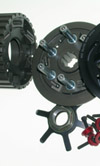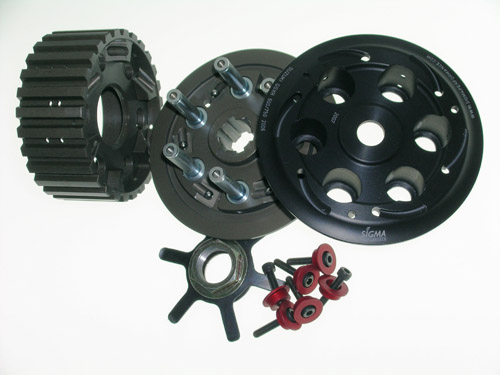Back Torque Limiters
 Back Torque Limiters - what are they and why would you possibly need one?More commonly known as slipper clutches the back torque limiter has been one of the major growth businesses in motorcycling during the last few years.Its all about grip and smoothness. Motorcycles have tiny tyre contact patches compared to cars and the racers that can manage that contact patch and maximise the grip available will be the winners..
Back Torque Limiters - what are they and why would you possibly need one?More commonly known as slipper clutches the back torque limiter has been one of the major growth businesses in motorcycling during the last few years.Its all about grip and smoothness. Motorcycles have tiny tyre contact patches compared to cars and the racers that can manage that contact patch and maximise the grip available will be the winners..
A back torque limiter is a clutch that deliberately slips in a smooth and controlled manner as the rear wheel tries to turn over the engine. Most clutches are simple ramp style mechanisms, a one way ramp and ball mechanism under the centre of the clutch pushes the centre of the multiplate clutch up as the rear wheel tries to drive the engine through the transmission. As a result the clutch disengages as the ‘rising centre’ pushes the pressure plate of the top of the plate stack, disengaging the motor.As soon as the clutch disengages of course there is no source of power to drive the clutch centre up the ramp, and the centre starts to fall, allowing the clutch to re-engage and the process to start again. In practice, depending on the angle of the ramps and the spring pressures chosen the clutch finds an equilibrium that allows only partial engine braking to be transferred through.So why do motorcycles need this mechanism when the engine braking could be a valuable additional brake? It’s all about the way the chassis of a bike is allowed to pitch around to maximise grip in certain circumstances. Lets just consider a bike coming out of one corner and diving into another.. what happens when and why?The bike is leaned right over, the rider applies throttle and the resulting centrifugal force brings the bike upright. As power continues to increase it is better to have the largest possible contact patch on the rear tyre. The bike rolls back on its suspension and loads up the rear tyre, compressing the sidewalls and flattening out a larger than normal contact patch. In addition the rear drive chain is acting to try and extend the rear suspension by the nature of the relation ship between the front drive sprocket, the swingarm pivot point and the rear sprocket. This adds additional pressure on the contact patch and helps move some of the bike weight forward.As the bike enters the next corner the brakes are applied and the front suspension dives, transferring load to the front tyre, flattening that contact patch and allowing more aggressive braking. As the rear tyre sees load transferred the front however the same settings that pushed the rear tyre in to the ground under acceleration are now trying to lift the entire wheel off the ground. The transfer of load to the front, the pitching forward of the entire motorcycle and the desire of the rear wheel to hop as it tries to use whatever grip is left to turn the engine over compression means that any mechanism that can disengage the engine will add to the available grip and will greatly stabilize corner entry feel. One additional benefit is that the ‘slipper clutch’ acts to help reduce engine over-rev as well.One alternative solution is to use the engines throttles to increase the effective tickover level corner by corner to eliminate the engine braking, this has been very successful in recent years amongst race classes using sufficiently sophisticated throttle systems.

The current trend of the increasing use of motorcycle engine/gearbox units in small displacement racing cars, begs the question of whether the slipper clutch is relevant here. In a racing car the potential benefits are more in the way of stopping over-revving and reducing stress on the gearbox, primary gears and crank bearings near the primary gears. Motorcycle constructors typically design gearboxes that are smaller and lighter than their automotive counterparts; this is because the levels of grip are so low and there is no point carrying around a gearbox that is heavier than you can use. Of course, if the bike engine is put into a car chassis, with loads of grip, it can cause problems. The same for over-revving on down shifts. The grip levels afforded by a race car will easily get a motorcycle engine over-revving, without any of the hopping and skipping of the rear wheel that occurs on a bike but which also helps prevent severe engine damage.